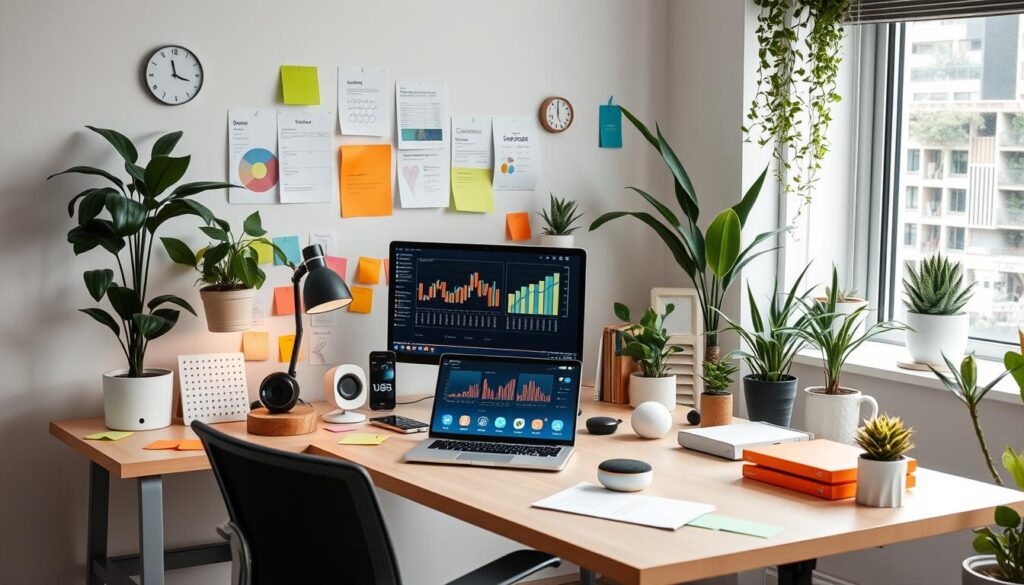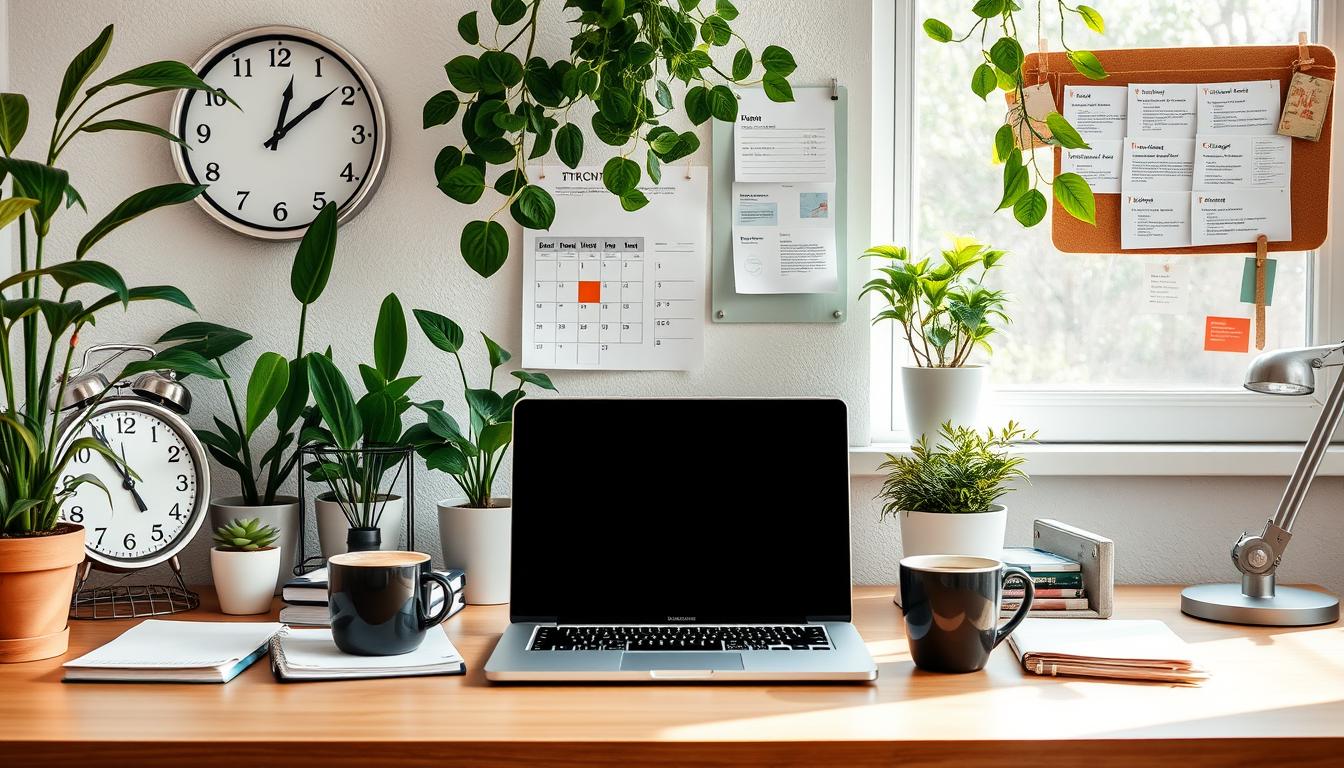Every morning, I’d look at my to-do list and feel overwhelmed. Hours would pass without making any real progress. This struggle with time management was a big part of my work life until I found some powerful strategies.
Being productive isn’t about working longer hours. It’s about working smarter. By using the right time management techniques, you can do more with less stress. These 13 tips will help you take back control of your workday and get better results.
Today’s professionals face big challenges in balancing work and life. There are distractions everywhere, from social media to endless emails. Being able to focus and prioritize is key in today’s busy work world.
Table of Contents
Understanding Your Biological Prime Time
Your body has a natural rhythm that affects your energy and productivity. Knowing your biological prime time can change how you plan your day. It helps you perform better every day.
Identifying Peak Energy Hours
Everyone’s energy levels change throughout the day. Your biological prime time is when you’re at your best. Most people are most alert between late morning and early afternoon. But, everyone is different.
- Track your energy levels hourly for at least three weeks
- Observe your natural concentration patterns
- Note times when you feel most alert and motivated
Tracking Your Natural Rhythm
Understanding your personal energy cycle requires consistent monitoring and self-awareness. Use tools or journals to track your productivity. Look for when you’re most sharp, motivated, and good at solving problems.
“Know your body’s rhythm, and you’ll unlock your true productivity potential.”
Optimizing Your Schedule
After finding your biological prime time, plan your hardest tasks for those hours. Save routine tasks for when you have less energy. This way, you’ll do better at work and feel happier.
Remember, your prime time can change with age, lifestyle, and life events. Keep checking to stay at your best.
Creating an Effective Workspace Environment
Your workspace is more than a place to sit. It’s a key to boosting your focus and getting things done. To make it work best, you need to plan and design it carefully.
Good workspace organization is not just about being neat. It’s about making a space that helps you think clearly and work well. With the right design, you can work smarter and get more done.
“Your environment is the silent architect of your productivity.” – Workspace Design Expert
- Get rid of clutter that messes with your mind
- Choose furniture that’s good for your body
- Set up different areas for different tasks
- Make sure the lighting and sound are just right
Smart organization in your workspace can cut down on distractions. It helps you stay focused. Here are some important things to think about:
| Workspace Element | Productivity Impact |
|---|---|
| Noise-Canceling Headphones | Reduces external distractions by 75% |
| Adjustable Desk | Improves posture and energy levels |
| Natural Lighting | Increases mental alertness by 40% |
Technology is also key to a great workspace. Use tools for talking and managing projects to make your work flow better. Remember, a well-designed workspace is an investment in your professional success.
The Power of Strategic Planning
Strategic planning changes how you work by giving you a clear path to success. It’s a strong tool that links your daily tasks to your long-term goals. This way, every minute is valuable.
Good strategic planning is more than just making lists. It’s about managing your time well to reach your full potential and make real progress.
Time Blocking Techniques
Time blocking is a key strategy for planning. It involves:
- Splitting your day into focused periods
- Setting aside specific times for important tasks
- Reducing distractions during work
“Strategic planning is the compass that guides your productivity journey.” – Business Growth Expert
Daily Planning Methods
Your daily planning should be both flexible and structured. Try these methods:
- Make a task list with priorities each morning
- Use digital tools to manage tasks
- Check and change your plan often
Setting Realistic Goals
Setting goals is key to strategic planning. Link your daily tasks to bigger goals by:
- Setting clear, measurable goals
- Breaking big goals into smaller steps
- Matching individual tasks with team or company goals
Companies like Apple and Google show how strategic planning leads to success. By using these methods, you can boost your productivity and get great results.
How to be More Productive with Deep Work
Unlocking your true productivity starts with mastering deep work. This idea, made famous by Cal Newport, changes how we focus. Deep work means being fully engaged without distractions, pushing your mind to its limits.
“Deep work is the ability to focus without distraction on a cognitively demanding task.” – Cal Newport
To do deep work well, try these strategies:
- Create a dedicated workspace free from interruptions
- Turn devices to “do not disturb” mode
- Use noise-canceling headphones
- Establish specific concentration windows
Newport shares deep work strategies to boost your productivity:
- Monastic Approach: Complete isolation for maximum focus
- Bimodal Approach: Alternating between deep and shallow work periods
- Rhythmic Approach: Establishing consistent deep work routines
Studies show 60% of knowledge workers’ time is spent on coordination tasks. By focusing deeply, you can greatly improve your work quality and speed. Deep work boosts productivity and helps your brain learn new skills faster.
Enhance your deep work by embracing boredom, avoiding social media, and grouping shallow tasks. Remember, it can take over 20 minutes to get back into focus after a break. So, it’s key to protect your concentration.
Mastering Task Prioritization
Effective task prioritization is key to being productive. Knowing how to manage your workload well can greatly improve your time use. This leads to better results.
Professionals know that not all tasks are the same. The secret to being productive is figuring out which tasks really matter.
Using the 80/20 Rule
The Pareto Principle shows a big truth: 80% of your results come from just 20% of your efforts. By focusing on your most important tasks, you can boost your productivity a lot.
- Find your most critical 20% of tasks
- Give more time and energy to these tasks
- Reduce time on less important tasks
Urgent vs Important Tasks
“What is important is seldom urgent, and what is urgent is seldom important.” – Dwight D. Eisenhower
Not all urgent tasks need your immediate focus. The Eisenhower Matrix helps sort tasks by their real importance:
| Quadrant | Characteristics | Action |
|---|---|---|
| Urgent & Important | Critical deadlines | Do immediately |
| Important, Not Urgent | Strategic planning | Schedule time |
| Urgent, Not Important | Interruptions | Delegate |
| Neither Urgent Nor Important | Time-wasting activities | Eliminate |
Decision-Making Frameworks
Good decision-making is vital for task prioritization. Here are some strategies:
- Use the MoSCoW method (Must, Should, Could, Won’t)
- Implement grid analysis for complex decisions
- Apply the Kano model for understanding task impact
By mastering these task prioritization techniques, you’ll boost your productivity. You’ll focus on what really matters.
Breaking Free from Multitasking

Your brain isn’t made for doing many things at once. Stanford University found that multitasking really cuts down on productivity. It actually makes things worse.
“Focusing on one task at a time is the key to true productivity.” – Productivity Expert
Monotasking is the better way to work better. By focusing on just one thing, you can do it better and faster. Switching between tasks is hard for your brain, making you less effective and tired.
- Eliminate distractions that fragment your attention
- Create dedicated time blocks for specific tasks
- Practice single-tasking to enhance concentration
- Implement mindful working strategies
Research shows that people who multitask a lot face big problems with:
| Cognitive Function | Multitasking Impact |
|---|---|
| Attention Span | Severely Reduced |
| Information Recall | Significantly Impaired |
| Task Switching | Inefficient Performance |
To get better at focusing, try the Pomodoro method. Work in 25-minute blocks, then take short breaks. This keeps your mind clear and stops you from getting too tired. Remember, quality trumps quantity in productive work.
To stop multitasking, turn off digital alerts, make a quiet workspace, and focus on one thing at a time. Your brain will be happier and work better.
Time Management Techniques that Work
Learning to manage time well is key to doing more and wasting less. People at work always look for ways to use their time better. The right methods can change how you do your daily tasks and reach your goals.
Good time management is about being smart, not just working hard. Here are three powerful ways to change how you work:
The Pomodoro Method
Francesco Cirillo created this method to keep focus sharp. It divides work into 25-minute blocks, with 5-minute breaks in between. This method stops burnout and keeps your energy up all day.
- Work in 25-minute focused sessions
- Take a 5-minute break after each session
- Complete four “pomodoros” before a longer 15-30 minute break
Time Boxing Strategies
Time boxing is about setting specific times for tasks. It makes tasks feel urgent and stops them from taking too long.
| Task | Allocated Time | Purpose |
|---|---|---|
| Email Management | 30 minutes | Prevent email overwhelm |
| Project Planning | 1 hour | Focused strategic thinking |
| Creative Work | 2 hours | Uninterrupted deep work |
Getting Things Done (GTD) System
David Allen’s GTD system helps organize tasks and clear your mind. The two-minute rule is simple: do tasks that take less than two minutes right away, not later.
“Your mind is for having ideas, not holding them.” – David Allen
Using these time management tips can make you work better, feel less stressed, and have more time for important things.
Eliminating Work About Work
Imagine spending most of your workday on tasks that aren’t actually work. Asana’s Anatomy of Work Index shows 60% of workers’ time is wasted on “work about work”. This includes searching for info, managing emails, and switching apps.
This waste affects your efficiency and task management. To fight it, use strategic productivity tools that make workflows smoother.
“Time is what we want most, but what we use worst.” – William Penn
Key Strategies to Reduce Work About Work
- Centralize communication platforms
- Implement comprehensive task management software
- Standardize team processes
- Minimize unnecessary meetings
- Automate repetitive administrative tasks
Remote workforce management systems track performance in real-time. They help spot and fix inefficiencies. By monitoring tasks and workflow bottlenecks, productivity can soar.
Productivity Tool Comparison
| Tool Feature | Basic Tier | Advanced Tier |
|---|---|---|
| Monthly Price | $6/user | $150/license |
| Free Trial | 14 days | 30 days |
| Tracking Methods | Project-based | 24/7 Unlimited |
By cutting down on “work about work”, you make room for tasks that really matter. These tasks lead to progress and job satisfaction.
The aim is not just to be busy. It’s to be strategically productive. Choose tools and practices that focus on what’s truly important.
Leveraging Productivity Tools and Automation
Technology has changed how we work, offering powerful tools to boost productivity. By using productivity software and automation, you can make your work easier. This helps you do more in less time.

Today, businesses are quickly adopting digital tools to get better at work. Gartner says 80% of executives believe automation can be applied to crucial business decisions. This change can save a lot of time and make work better in many areas.
Task Management Software
Keeping tasks organized is key to staying productive. There are many platforms to help you stay on track:
- Trello: Visual project tracking
- Asana: Team collaboration and workflow management
- Monday.com: Comprehensive project planning
Automation Tools
Automation tools cut down on repetitive tasks. Businesses can save 240-360 hours per year by using smart automation.
| Automation Tool | Primary Function | Time Saved |
|---|---|---|
| Zapier | App Integration | Hours per Week |
| IFTTT | Task Chaining | Multiple Hours |
| RPA Software | Process Automation | 100+ Hours Annually |
Communication Platforms
Remote work needs good communication tools. Platforms like Zoom, Microsoft Teams, and Slack help teams work together well. They keep everyone connected and productive.
“Automation is not about replacing humans, but empowering them to focus on high-value work.” – Tech Innovation Expert
By using productivity software, automation, and digital tools, you can change how you work. You’ll do less manual work and achieve great efficiency.
Maintaining Work-Life Balance
Getting a good work-life balance is key to lasting productivity. Today’s jobs ask for a lot of focus, but don’t forget about your health. Finding the right mix between work and personal life can really boost your performance and happiness.
“Balance is not something you find, it’s something you create.” – Unknown
Managing stress is vital for staying productive. Here are some important tips to keep your work and personal life in check:
- Set clear boundaries between work and personal time
- Create dedicated spaces for work and relaxation
- Practice regular self-care routines
- Schedule breaks throughout your workday
- Learn to disconnect from digital devices
Workplace burnout is a big problem. Companies lose $322 billion globally because of it. Also, 55% of workers say they’re burned out because of work-life issues.
| Work-Life Balance Metric | Statistic |
|---|---|
| Employees Working Over 50 Hours | 40% |
| Employees Experiencing Monthly Burnout | 70% |
| Employees with Unused Vacation Days | 55% |
To fight burnout and boost productivity, focus on your mental health. Try flexible work hours, take breaks, and live a healthy lifestyle. Success is about balance, not just working hard all the time.
Building Sustainable Productivity Habits
Building lasting productivity habits is key to success. Your path to consistent high performance starts with creating habits that help you grow professionally.
“Productivity is all about efficiency” – Productivity Experts
Creating habits needs a smart plan. Your brain likes routine, and making consistent productivity habits can change your work life. Here are important strategies for lasting productivity habits:
- Start small with achievable daily goals
- Track your progress systematically
- Create accountability mechanisms
- Regularly review and adjust your approach
The most productive people know that being consistent is more important than being intense. They focus on sustainable practices instead of short bursts of energy. Using time management techniques like the Pomodoro Technique helps keep you focused and avoids burnout.
| Habit | Impact on Productivity |
|---|---|
| Morning Planning | Increases daily goal achievement by 40% |
| Regular Break Scheduling | Improves mental clarity and focus |
| Weekly Habit Review | Enables continuous improvement |
Remember, lasting productivity isn’t about working harder, but smarter. Setting S.M.A.R.T. goals helps you work more efficiently. Focus on tasks that have the biggest impact, following the 80/20 rule.
Your goal is to make a productivity system that feels natural and fits your style. Be flexible, patient with yourself, and keep improving your methods.
Conclusion
Improving productivity is a journey of learning and self-improvement. It’s not about working harder, but smarter. 78% of successful people say good time management is key to their success.
Understanding your work patterns is crucial. Break down big projects, focus on important tasks, and avoid multitasking. This approach boosts your work output. Techniques like the Pomodoro method and time blocking help stay focused and reduce stress.
Productivity is very personal. What works for one person might not work for another. Find what works best for you, considering your strengths, energy levels, and work environment.
Creating good habits, taking breaks, and living a balanced life are key to lasting productivity. Use these tips to improve your work performance. Your dedication to better time management and efficiency will lead to greater success and happiness.
FAQ
What is biological prime time and how can I identify it?
Biological prime time is when you’re most energetic and productive. To find out when this is for you, track your energy every hour for three weeks. Stay away from alcohol, coffee, and antidepressants during this time.
This helps you see your natural energy patterns. Then, plan your toughest tasks when you have the most energy.
How can I improve my workspace to boost productivity?
Make your workspace better by cutting down on distractions. Use headphones to block out noise and get a comfy chair. A tidy desk helps you stay focused.
Control your environment to work better and avoid interruptions.
What is deep work, and how can I practice it?
Deep work means focusing without distractions, pushing your brain to its limits. To do deep work, turn off your devices and wear headphones. Limit social media and schedule focused time during your best hours.
Try having a day without meetings to work without breaks.
Is multitasking an effective way to increase productivity?
No, multitasking makes you less productive. Your brain can’t handle many tasks at once. Instead, focus on one thing at a time.
Try the Pomodoro method for 25 minutes of work followed by a 5-minute break. It helps you stay focused and adds a sense of urgency.
How can I prioritize tasks more effectively?
Focus on the 20% of work that gives you 80% of the results. Separate urgent from important tasks to avoid wasting time. Use frameworks to quickly decide which tasks to do first.
Choose tasks that will make a big difference to see progress.
What are some practical time management techniques?
Good time management includes the Pomodoro Technique and time boxing. The Getting Things Done (GTD) system is also helpful. Time blocking helps you focus on specific tasks during the day.
How can technology help improve productivity?
Use software like Asana or Notion for tasks. Automation tools and communication platforms help too. AI can help with creative tasks, and management systems track your progress.
How important is work-life balance for productivity?
Work-life balance is key for lasting productivity. Take breaks and live healthily. Avoid burnout by not overworking.
Do things that make you happy and keep your mind and body healthy. It’s vital for staying productive over time.
What’s the best way to build sustainable productivity habits?
Start by finding your peak energy hours and planning your day. Practice deep work and avoid multitasking. Use consistent time management and keep your workspace clean.
Take care of your health and use apps to track your habits. Keep improving your methods to find what works best for you.


3 thoughts on “How to be more productive: 13 productivity tips”